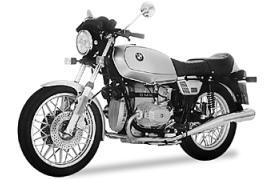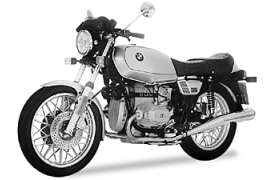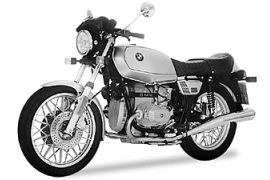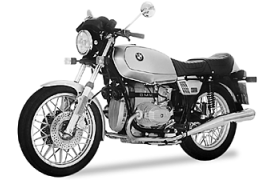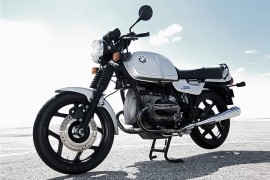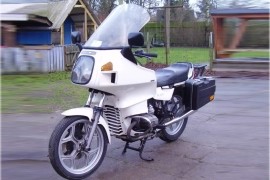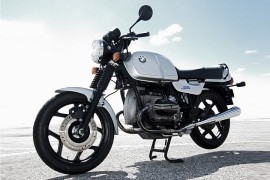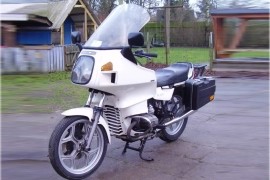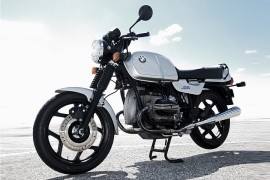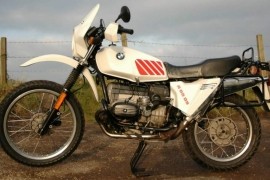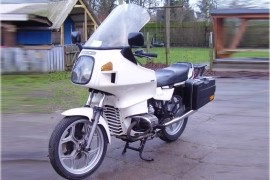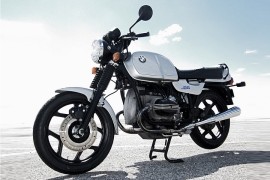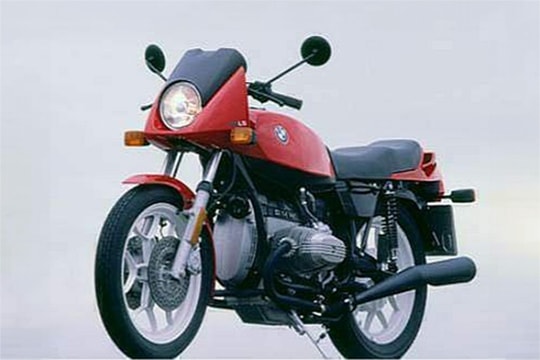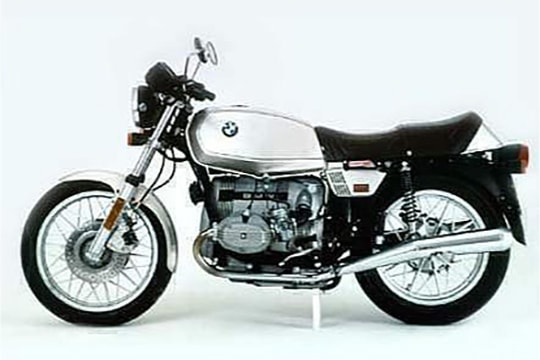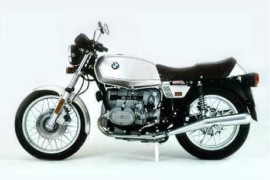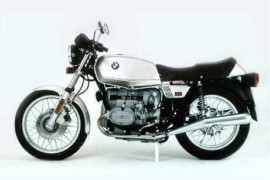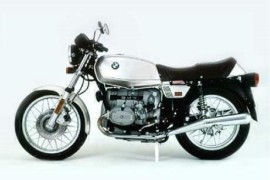BMW R 65 Models/Series Timeline, Specifications & Photos
First production year: 1978
In 1992, the German motorcycle manufacturer released the BMW R 65 Monolever, a middle-sized touring motorcycle with a monolever suspension system on the rear since 1985. It was manufactured until 1993.
The 1993 model featured the same package as the previous one, offering the same technical, visual, and performance specifications without any significant modifications whatsoever.
The bike had standard features in the aesthetic department, such as a round headlight, a one-piece dual seat with passenger grab rails, a two-into-two exhaust system with a silencer mounted on each side, a center stand, and alloy wheels.
The bike's riding experience was softened by a hydraulic telescopic fork on the front that provided 175 mm of travel and a monolever swingarm with a right-hand side-mounted shock absorber that offered 120 mm of travel.
As for the braking power, the motorcycle's wheels were fitted with two 260 mm brake discs with dual-piston calipers mounted on the front and a 200 mm drum braking unit on the rear, offering optimum stopping performance.
In the performance department, the 1993 BMW R 65 had its heartbeat set by a 649cc four-stroke air-cooled twin-cylinder boxer engine that delivered 45 hp at 7,250 rpm and 45 Nm (33 lb-ft) torque at 6,000 rpm.
The power generated by the engine was sent to a five-speed manual transmission with a dry single-plate clutch. It was sent to the rear wheel via a final shaft drive, pushing the motorcycle to a top speed of 169 kph (105 mph).
The BMW R 65 was a light touring motorcycle produced by BMW in 1978 as a mid-sized motorcycle. The touring bike was manufactured for over five years, from 1978 to 1984. It was made alongside the BMW R 45, which had a smaller displacement engine.
BMW introduced the R 65 Monolever in 1985 as a successor to the small series, based on the success of the 800cc R 80 and R 80 RT versions. The R 65 Monolever combined the single-sided swingarm frame concept of the 800cc models and the 650cc short-stroke engine used by the old R 65 and R 65 ls models.
In 1991, the German motorcycle maker introduced the BMW R 65 Monolever, a mid-sized touring motorcycle in its seventh production year wearing the monolever system. It was created for riders searching for a fuel-efficient machine to handle weekend strolls and occasional highway hauls.
The bike’s visual department was characterized by standard features, like alloy wheels, a center stand, a monolever system on the rear, a dual exhaust system with a silencer mounted on each side, a one-piece dual seat, and a round headlight upfront.
As for power, the 1991 BMW R 65 had its soul brought to life by a 649cc four-stroke twin-cylinder air-cooled boxer engine that delivered 45 hp with a peak force at 7,250 rpm and 45 Nm (33 lb-ft) torque at 6,000 rpm.
In 1990, the German motorcycle maker released the BMW R 65, a middle-class naked motorcycle that offered high levels of comfort and safety. It was fuel-efficient and could handle weekend strolls and highway hauls.
The BMW R 65 debuted in 1978 as a mid-sized touring-oriented motorcycle and continued production until 1984. From 1985 until 1993, the Monolever version was made using a monolever system on the rear.
Compared to the previous model, the 1990 BMW R 65 came in the same shape and form, offering the same technical, visual, and performance specifications without any significant modifications whatsoever.
In the aesthetic department, the bike had standard features such as alloy wheels, a center stand, dual shock absorbers on the rear, a dual exhaust system with a silencer mounted on each side, a one-piece dual seat, and a round headlight upfront.
The bike’s suspension system comprised a hydraulic telescopic fork on the front that provided 175 mm of travel and a monolever swingarm with dual side-mounted shock absorbers on the rear that offered 120 mm of travel.
As for the braking power, the bike's wheels were fitted with two 260 mm brake discs with dual-piston calipers mounted on the front wheel and a 200 mm drum braking unit on the rear, offering optimum stopping performance.
The 1990 BMW R 65 Monolever was powered by a 649cc four-stroke air-cooled twin-cylinder boxer engine that delivered an output power of 45 hp at 7,250 rpm and 45 Nm (33 lb-ft) torque at 6,000 rpm.
In 1989, the German motorcycle manufacturer released the BMW R 65 Monolever, a motorcycle created by the House of Munich for those riders looking for fuel-efficient daily commuters who could also handle weekend strolls and even highway hauls.
The BMW R 65 was a light touring motorcycle produced by BMW in 1978 as a mid-sized motorcycle. The touring bike was manufactured for over five years, from 1978 to 1984. It was made alongside the BMW R 45, which had a smaller displacement engine.
The 1989 model came in the same shape and form as the previous one, delivering the same technical, visual, and performance specifications without any significant modifications whatsoever.
The bike’s aesthetic department was characterized by standard features, such as a round headlight, a one-piece dual seat with passenger grab rails, a two-into-two exhaust system with a silencer mounted on each side, a center stand, and alloy wheels.
Underneath its fuel tank, the 1989 BMW R 65 Monoleverhad installed a 649cc four-stroke twin-cylinder air-cooled boxer engine controlled by two Bing carburetors, boasting 45 hp with a peak force at 7,250 rpm and 45 Nm (33 lb-ft) torque at 6,000 rpm.
The bike’s riding experience was softened by a hydraulic telescopic fork on the front that provided 175 mm of travel and a monolever swingarm with a right-hand side-mounted shock absorber that offered 120 mm of travel.
The BMW R 65 was a light touring motorcycle manufactured by BMW in 1978 as a mid-sized motorcycle. The touring bike was manufactured for over five years, from 1978 to 1984. It was produced alongside the BMW R 45, which had a smaller displacement engine.
In 1988, the German motorcycle manufacturer released the BMW R 65 Monolever, one of the smallest displacement motorcycles in BMW's line-up. It came in the same shape and form as the previous one without significant modifications.
The motorcycle packed standard fittings in the visual department, such as a round headlight, a one-piece dual seat with passenger grab rails, a two-into-two exhaust system with a silencer mounted on each side, a center stand, and alloy wheels.
Suspension-wise, the bike was equipped with a hydraulic telescopic fork on the front that provided 175 mm of travel and a monolever swingarm with a right-hand side-mounted shock absorber that offered 120 mm of travel.
As for the braking power, the bike's wheels were fitted with two 260 mm brake discs with dual-piston calipers mounted on the front wheel and a 200 mm drum braking unit on the rear, offering optimum stopping performance.
The 1988 BMW R 65 Monolever had its heartbeat set by a 649cc four-stroke twin-cylinder air-cooled boxer engine boasting 45 hp with a peak force at 7,250 rpm and 45 Nm (33 lb-ft) torque at 6,000 rpm.
In 1987, the German motorcycle maker released the BMW R 65 RT Monolever, a touring-oriented version of the base R 65 Monolever with several touring-oriented accessories that enhanced its long-hail capabilities.
The BMW R 65 RT Motolever was a touring-oriented motorcycle best suited for those riders who wanted to spend as much time behind bars but also wanted a fuel-efficient and agile bike.
The 1987 BMW R 65 RT Monolever was set in motion by a 649cc four-stroke air-cooled twin-cylinder boxer engine mounted underneath its fuel tank, delivering 48 hp at 7,250 rpm and 45 Nm (33 lb-ft) torque at 6,000 rpm.
The power produced by the engine pushed the bike to a top speed of 169 kph (105 mph) through a five-speed manual transmission with a dry single-plate clutch and a final shaft drive.
Aesthetically, the motorcycle had standard features, like a full fairing with a round headlight, a large windscreen, a one-piece dual seat with a passenger grab rail, a luggage rack, side-mounted panniers, a dual exhaust system, a center stand, and aluminum alloy wheels.
The bike's suspension system comprised a hydraulic telescopic fork on the front with 175 mm of travel and a monolever suspension system on the rear with 120 mm of travel, offering optimum suspension performance and handling.
The BMW R 65 was a light touring motorcycle manufactured by BMW in 1978 as a mid-sized motorcycle. The touring machine was manufactured for over five years, from 1978 to 1984. It was produced alongside the BMW R 45, which had a smaller displacement engine.
BMW introduced the R 65 Monolever in 1985, which was presented as a successor to the small series and was based on the success of the 800cc R 80 and R 80 RT versions. The R 65 Monolever combined the single-sided swingarm frame concept of the 800cc models and the 650cc short-stroke engine used by the old R 65 and R 65 ls models.
In 1987, the German motorcycle manufacturer released the BMW R 65 Monolever, a mid-sized touring motorcycle, in its third consecutive production year. As its name suggests, the bike had a monolever system on the rear.
The motorcycle's visual department was characterized by standard features, such as a round headlight, a one-piece dual seat with passenger grab rails, a two-into-two exhaust system with a silencer mounted on each side, a center stand, and alloy wheels.
In the performance department, the 1987 BMW R 65 Monolever had installed a 649cc four-stroke air-cooled twin-cylinder boxer engine underneath the fuel tank, delivering 45 hp at 7,250 rpm and 45 Nm (33 lb-ft) torque at 6,000 rpm.
The BMW R 65 RT Motolever was a touring motorcycle suited for riders who wanted to spend as much time behind bars but also wanted a fuel-efficient and agile bike.
In 1986, the German motorcycle manufacturer released the BMW R 65 RT Monolever, a touring motorcycle with the same package as the previous one, offering the same specifications without any changes.
The bike's visual department was characterized by standard fittings, like a full fairing with a round headlight, a large windscreen, a one-piece dual seat with a passenger grab rail, a luggage rack, side-mounted panniers, a dual exhaust system, a center stand, and aluminum alloy wheels.
In the power department, the 1996 BMW R 65 Monolever had installed a 649cc four-stroke air-cooled twin-cylinder boxer engine underneath its fuel tank, boasting 48 hp at 7,250 rpm and 45 Nm (33 lb-ft) torque at 6,000 rpm.
A five-speed transmission controlled by a dry single-plate clutch redirected the power generated by the engine to the rear wheel through a final shaft drive, launching the touring machine to a top speed of 169 kph (105 mph).
The front end was handled by a hydraulic telescopic fork with 175 mm of travel and two 260 mm brake discs tied to dual-piston calipers. In contrast, the rear end was controlled by a Monolever system and a 200 mm drum braking unit.
In 1986, the German motorcycle manufacturer released the BMW R 65 Monolever, a middle-class naked machine in its second production year. The bike came with the same package as the previous one, without any significant modifications.
The 1985 BMW R 65 was available in two versions with different performance levels that suited both beginners with the 27 hp model and the more seasoned ones with the 48 hp model. Compared to its predecessor, the two-hp reduced output was achieved with reduced engine compression.
The motorcycle packed standard features in the visual department, such as a round headlight, a one-piece dual seat with passenger grab rails, a two-into-two exhaust system with a silencer mounted on each side, a center stand, and alloy wheels.
The bike's suspension system comprised a hydraulic telescopic fork on the front with 175 mm of travel and a monolever swingarm with a right-hand side-mounted shock absorber that offered 120 mm of travel.
As for the braking power, the motorcycle packed two 260 mm brake discs with dual-piston calipers on the front wheel and a 200 mm drum braking unit on the rear, offering optimum stopping performance.
As for the power figures, the 1986 BMW R 65 Monolever had its soul brought to life by a 649cc four-stroke air-cooled twin-cylinder boxer engine mounted underneath the fuel tank, delivering 45 hp at 7,250 rpm and 45 Nm (33 lb-ft) torque at 6,000 rpm.
In 1987, alongside the R 80 GS and R 100 GS models, BMW launched the R 65 GS as an entry-level version for riders that were particularly attracted by two-cylinder enduro motorcycles.
Visually, the 1987 BMW R 65 GS was identical to the discontinued R 80 G/S model, with the only difference being the displacement of the single-cylinder engine, which had 650cc with 27 hp instead of 800cc with 50 hp.
The trust of the R 65 GS came from the 649cc flat-twin engine with a power output of 27 hp at 5,500 rpm and 45 Nm (33 lb-ft) of torque available at 6,000 rpm in combination with a five-speed manual transmission and a low curb weight of 198 kg (436 lbs), the bike registered a top speed of 146 kph (91 mph).
The enduro motorcycle came with standard features such as laced wheels, knobby tires, a dual seat, a rear luggage rack, passenger grab rails, a telescopic front fork, a Monolever rear suspension, front 260 mm disc brakes coupled to a rear 200 mm drum unit, a small fairing, an analog instrument cluster, and a center stand.
The model, with its low curb weight and the well-tuned high torque boxer engine, was very agile to drive, but unfortunately, the low sales figures forced BMW to take the model out of the program in 1992.
In 1985, the German motorcycle manufacturer released the BMW R 65 RT Monolever, a touring motorcycle suited for riders who wanted to spend as much time as possible behind bars but also wanted a fuel-efficient and agile two-wheeler.
In the visual department, the bike packed standard features, such as a full fairing with a round headlight, a large windscreen, a one-piece dual seat with a passenger grab handle, a luggage rack, side-mounted panniers, a dual exhaust system, a center stand, and aluminum alloy wheels.
The bike's suspension system comprised a hydraulic telescopic fork on the front with 175 mm of travel and a monolever suspension system on the rear with 120 mm of travel, offering optimum suspension performance and handling.
The braking power was handled by two 260 mm brake discs with dual-piston calipers mounted on the front wheel and a single 200 mm drum braking unit on the rear that offered optimum stopping performance.
As for the power figures, the 1985 BMW R 65 RT Monolever had its soul brought to life by a 649cc four-stroke air-cooled twin-cylinder boxer engine with two Bing carburetors in charge, boasting 48 hp at 7,250 rpm and 45 Nm (33 lb-ft) torque at 6,000 rpm.
The bike's engine was coupled to a five-speed manual transmission with a dry single-plate clutch, sending the power to the rear end via a final shaft drive, pushing the motorcycle to a top speed of 169 kph (105 mph).
In 1985, BMW released the R 65 Monolever, which was presented as a successor to the small series and was based on the success of the 800cc R 80 and R 80 RT versions. The R 65 Monolever combined the single-sided swingarm frame concept of the 800cc models and the 650cc short-stroke engine used by the old R 65 and R 65 ls models.
The 1985 BMW R 65 was available in two versions with different performance levels that fitted both beginners with the 27 hp model and the more seasoned ones with the 48 hp model. Compared to its predecessor, the two-hp reduced output was achieved with reduced engine compression.
The R 65 Monolever was powered by a 649cc flat-twin engine with a power output of 48 hp at 7,250 rpm and 45 Nm (33 lb-ft) of torque available at 3,000 rpm. The power produced by the engine was sent to a five-speed manual transmission that pushed the bike to a top speed of 173 kph (106 mph).
The double-loop tubular steel frame with a bolted rear section packed a telescopic fork on the front end and a BMW Monolever swingarm on the rear wheel, acting as suspension.
Packed from the factory, the model came with standard features such as lightweight cast-aluminum wheels, a dual seat, passenger grab rails, a dual exhaust system, an analog instrument cluster, a center stand, a blacked-out steel frame, and a center stand with the scale tipped at 205 kg (452 lbs).
In 1982, BMW launched the R 65 LS, a sporty version of the R 65, and expanded the small series. Based on the R 65, the LS (Luxury Sport) was revised in the engine and chassis departments and upgraded with some special technical features.
Visually, the bike had a futuristic-looking cockpit fairing and a newly designed combination of seat and rear apron and came in two color combinations such as Henna Red and Polaris Silver Metallic, each with a contrasting black underside of the tank, black side covers, and a black anodized exhaust system.
The 1982 BMW R 65 LS was powered by a 649cc flat-twin air-cooled boxer engine with a power output of 50 hp at 7,250 rpm and 52 Nm (38 lb-ft) of torque at 6,500 rpm. In conjunction with a five-speed manual transmission and a curb weight of 207 kg (456 lbs), the bike registered a top speed of 175 kph (107 mph).
For suspension, the model packed a telescopic fork with hydraulic shock absorbers on the front and a long swingarm with adjustable shock absorbers on the rear. As for braking, two 260 mm discs on the front and a 200 mm drum unit on the rear took care of the stopping power.
The bike had standard features such as a large round headlamp, cast-aluminum wheels, an analog instrument cluster, a dual seat, and a center stand.
The BMW R 65 was a light touring motorcycle manufactured by BMW in 1978 as a mid-sized motorcycle. The touring machine was manufactured for over five years, from 1978 to 1984. It was produced alongside the BMW R 45, which had a smaller displacement engine.
In 1981, the German motorcycle maker released the BMW R 65, a touring motorcycle in its fourth consecutive production year, with the same package as the previous one, delivering the same specifications without any significant modifications.
In the visual department, the 1981 BMW R 65 had standard features, such as multi-spoke lightweight aluminum alloy wheels, a round headlight upfront, a one-piece dual seat, a two-into-two exhaust system with a muffler mounted on each side, dual shock absorbers on the rear, and a center stand.
Suspension-wise, the motorcycle packed a telescopic fork on the front with 175 mm of travel and dual shock absorbers on the rear with 110 mm of travel, offering optimum suspension performance and handling.
As for the stopping power, the motorcycle's wheels were fitted with a single brake rotor on the front and a drum braking unit on the rear, offering optimum braking performance.
The 1981 BMW R 65 was powered by a 649cc four-stroke twin-cylinder air-cooled boxer engine that delivered 45 hp with a peak force at 7,250 rpm and 45 Nm (33 lb-ft) torque at 6,000 rpm.
In 1980, the German motorcycle maker released the BMW R 65, a touring motorcycle in its third consecutive production year, with the same package as the previous one, delivering the same specifications without any significant modifications.
The BMW R 65 was a light touring motorcycle introduced by BMW in 1978 as a mid-sized motorcycle. It was designed by German engineers to fit the taste of both experienced and less experienced riders among BMW fans.
The 1980 BMW R 65 was powered by a 649cc flat-twin engine with an output power of 45 hp at 7,250 rpm and 45 Nm (33 lb-ft) of torque at 6,000 rpm and a five-speed manual transmission that made it possible for the bike to reach a top speed of 175 kph (109 mph).
The bike had a telescopic fork on the front with 175 mm of travel and dual shock absorbers on the rear with 110 mm of travel, offering optimum suspension performance and handling.
As for the braking power, the motorcycle was controlled by a single brake disc mounted on the front wheel and a single drum braking unit mounted on the rear wheel, providing optimum stopping performance.
In the aesthetic department, the 1980 BMW R 65 had standard features, such as multi-spoke lightweight aluminum alloy wheels, a round headlight upfront, a one-piece dual seat, a two-into-two exhaust system with a muffler mounted on each side, dual shock absorbers on the rear, and a center stand.
The BMW R 65 was a light touring motorcycle introduced by BMW in 1978 as a mid-sized motorcycle. The bike was manufactured for over five years, from 1978 to 1984. It was manufactured alongside the BMW R 45, which had a smaller displacement engine.
In 1979, the German motorcycle maker released the BMW R 65, a mid-sized light touring motorcycle best suited for those riders searching for a machine with daily commuting capabilities but also able to take on longer journeys.
In the visual department, the motorcycle had installed standard features, such as multi-spoke lightweight aluminum alloy wheels, a round headlight upfront, a one-piece dual seat, a two-into-two exhaust system with a muffler mounted on each side, dual shock absorbers on the rear, and a center stand.
Suspension-wise, the motorcycle packed a telescopic fork on the front that offered 175 mm of travel and dual shock absorbers on the rear with 110 mm of travel, offering optimum suspension performance and handling.
As for the stopping power, the motorcycle was handled by a single brake disc mounted on the front wheel and a single drum braking unit mounted on the rear wheel, providing optimum stopping performance.
As for the power figures, the 1979 BMW R 65 had its soul brought to life by a 649cc four-stroke air-cooled two-cylinder boxer engine that delivered 45 hp at 7,250 rpm and 45 Nm (33 lb-ft) torque at 6,000 rpm.
In 1978, BMW launched the R 65 model alongside the R 45 as a small entry-level motorcycle. The R 65 had a larger displacement of 650cc compared to the R 45 and generated an output of 45 hp.
The 1978 BMW R 65 was powered by a 649cc flat-twin engine with a power output of 45 hp at 7,250 rpm and 45 Nm (33 lb-ft) of torque at 6,000 rpm. It was coupled to a five-speed manual transmission that made it possible for the bike to reach a top speed of 175 kph (109 mph).
The 260 mm double disc brake on the front and 200 mm drum brake on the rear handled the bike's stopping power.
Fitted from the factory, the model came with features such as laced wheels, a dual exhaust system, a dual seat, analog dials, wide handlebars, a large-capacity 22-liter (5.8-gallon) fuel tank, and a center stand.
A good contribution to the popularity of the R 65 was the revised model in 1981, with the power output increased to 50 hp, a low-weight and stable chassis that resulted in good handling and agility.
In 1985, the small series of the R65 and R45 were removed from the BMW product range due to the complex construction of the models that was more expensive than they expected.
